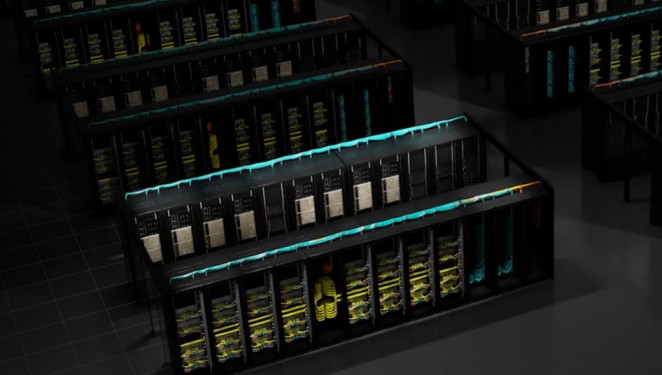Nvidia recently announced their new supercomputer named Eos. In flashy videos and announcements, Nvidia described Eos as an ultra-powerful “AI factory” that will drive major breakthroughs in artificial intelligence.
However, looking closer, there are some confusing things about Eos that make you wonder – is this mostly a marketing effort to get attention or will it really have a big impact on advancing AI?
What Do We Know About Eos?
First, let’s review the key details Nvidia has shared about Eos:
- It uses 576 servers packed with graphics chips called DGX H100s
- Each server has 8 advanced GPUs called H100s, so total Eos has 4,608 GPUs
- Those GPUs give it the computing power of 121 petaflops, ranking #9 fastest supercomputer
- The servers use high-end Intel central processors (CPUs)
- It has a specialized fast network connecting all the servers
So in terms of pure computing muscle for training artificial intelligence models, Eos is clearly an absolute beast.
But Nvidia seems to have changed how they talk about Eos. At first, back in November, they said Eos had over 10,000 H100 GPUs. Now they say it has less than 5,000. Why did the specs change? Unclear.
Is Eos for AI Research or Marketing?
Originally, Nvidia made it sound like Eos was designed specifically for their internal artificial intelligence researchers. They said it would power an “AI factory” to let them make ongoing breakthroughs.
But then Nvidia said there are multiple systems called Eos. If it is an AI research tool, why are there different Eos supercomputers? And why would another Eos need so many more GPUs?
This fuzzy messaging undercuts the idea that Eos was custom-built just for advancing Nvidia’s AI capabilities. It raises doubts about what Eos is really meant for. Is it doing pioneering research on future AI like GPT-4? Or was it mostly built to get attention and benchmark scores? Nvidia hasn’t clearly explained its purpose.
Impressive Parts, But What’s the Impact?
There’s absolutely no question that Eos uses incredibly powerful hardware. Combining thousands of high-capability GPUs and fast networking can clearly crank out some spectacular speeds for training AI models.
Nvidia did show benchmarks with Eos training a language model 4x faster than before. But that was testing performance, not applying Eos to meaningful real-world problems.
We still have no idea if Eos is actually being used to train production-level AI models or enable research that helps people.
Is anyone doing anything useful with it?
Nvidia hasn’t shared any specific projects or results powered by Eos itself. Until then, its real-world impact is uncertain no matter how fast it trains AI models.
Industry Leader or Marketing Showcase?
It’s common for tech giants like Nvidia to have in-house supercomputers to test things. But they don’t usually give them names and publicly announce them like standalone products.
By announcing Eos as a named product with press releases plus fancy videos, it feels more like Nvidia trying to hype up its engineering capabilities than provide real value to AI researchers.
Is Eos about selling more Nvidia products or discovering ideas that move society forward?
Unclear.
Without transparency on who gets access to Eos and what it’s specifically being used for, this feels more like flashy marketing than substantial progress. Nvidia wants to sound like an AI leader.
But true leadership is showing how your technology is helping real people – not just proclaiming you built an unnamed supercomputer in your headquarters.
Looking to the Future
In the end, supercomputers like Eos definitely have potential to drive AI progress through their extreme number-crunching power. But the shifting story around Eos shows there’s a gap between Nvidia’s PR priorities and it actually improving AI meaningfully.
Until Nvidia reveals specifics on who uses Eos, what projects run on it, and what discoveries or developments it enables directly, it’s hard to see it as more than a pursuit of benchmark records.
The AI community needs less fancy supercomputers locked away out-of-reach, and more clarity on how these systems are helping make people’s lives better.
If Nvidia clearly communicated how Eos contributes over time rather than keeping it behind closed doors, more people would trust them as an AI leader truly moving the field forward through ethical and inclusive innovation that lifts up society.
Frequently Asked Questions
What is Nvidia’s Eos supercomputer?
Eos is Nvidia’s recently announced supercomputer that contains 576 DGX H100 servers with a total of 4,608 H100 GPUs, delivering 121 petaflops of computing power. Nvidia has described it as an “AI factory” for breakthrough AI research.
How powerful is the Eos supercomputer?
According to Nvidia, Eos ranks as the 9th fastest supercomputer in the world with 121 petaflops of computing power. It contains 4,608 H100 GPUs connected with specialized networking technology.
Why are there questions about Nvidia’s Eos?
There are questions because Nvidia initially claimed Eos had over 10,000 H100 GPUs but later stated it has fewer than 5,000. Additionally, there’s a lack of transparency about what specific AI projects Eos is being used for and whether there are multiple systems called Eos.
What is Eos being used for?
This remains unclear. While Nvidia has demonstrated benchmarks showing Eos can train language models 4x faster than before, they haven’t shared specific research projects, production AI models, or real-world applications that Eos is powering.
Is Eos primarily for research or marketing?
This is the key question the article raises. Without clear information about who has access to Eos and what it’s being used for, it’s difficult to determine whether it’s primarily an important AI research tool or a marketing showcase for Nvidia’s hardware capabilities.
